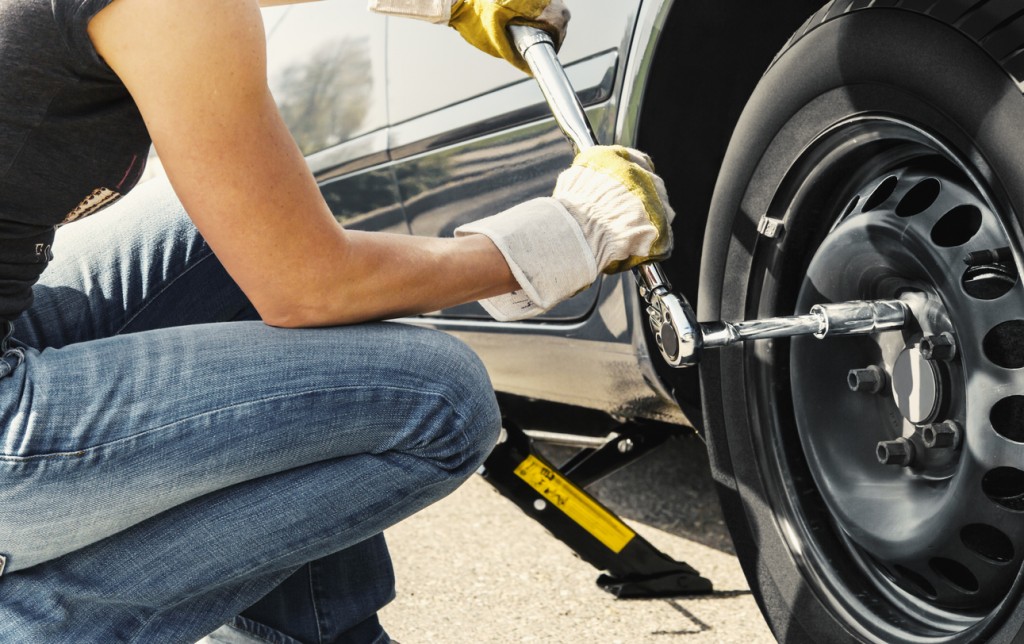As a motorist, you will one day be confronted with a flat tyre. It helps to be prepared. Some cars now come equipped with a puncture repair kit instead of spare tyre, but this is still a useful skill to learn. As further motivation, being able to change your own tyre can save you money and effort in the long run. So long as you are sensible and do your research, changing a tyre should be no problem at all.
Gathering Your Equipment
For starters, you are going to need a few pieces of equipment. Ideally, you should carry these in the car at all times. You never know when you’re going to have a flat tyre. The spare tyre, the car jack, the wrench, the locking wheel nut key and the vehicle handbook all come as standard when you buy a car. If not, it is extremely important that you source replacements. With the spare tyre, it is crucial that you regular check it to ensure it is still inflated and the condition is still good. A perished tyre is an unsafe tyre.
If you are changing the tyre at the roadside, a reflective jacket is a safety must. Whilst they may not be a necessity you will be far more comfortable with a pair of gloves and something appropriate to kneel on.
Preparation Time
Firstly, you need to ensure that the car is parked in a suitable position. A hard, even, flat surface is preferable, to ensure the vehicle doesn’t roll unexpectedly and come off the jack. Soft ground will prove problematic when it comes to lifting the weight car and your jack might just get stuck.
Make sure the engine is turned off, the handbrake is on and the car is in first gear or ‘P’ if an automatic. When working at the roadside, switch on your hazard lights.
Removing The Flat Tyre
Before jacking the car up, loosen any nuts or bolts using the wheel wrench. These can be extremely tight and it is far easier to work them loose with the car lowered with no risk of knocking the car off the jack. Do not, however, remove them completely. The wrench should be long enough for you to use your foot to get a bit more power and weight behind the movement. You can even stand on it if that helps! After a while you should be able to switch to just using your hands.
Bolts loosened, it is time to jack up the car. To find out the correct jacking position on your car, refer to the vehicle handbook. Generally, they will be behind the front wheel and in front of the rear wheel on both sides of the car. If your jack doesn’t come up a built-in handle, simply re-purpose your wheel wrench on one of the jack’s nuts.
You want to lift the car high enough that the wheel is clearly off the ground but the jack hasn’t reached its limit. Be careful to not put any part of your body under the car incase the jack was to fail. With the car jacked up, you can now completely remove those loosened bolts and pull the wheel off the car.
Fitting the Spare Wheel
Fitting the spare wheel is essentially the reverse of what we just outlined. Line the spare tyre up with the mount nuts and slide on. This can be a awkward so you might need any passengers to give you a hand. Tighten the wheel nuts as much as you can with your hand. It is not safe to use the wrench with the car in a jacked up position.
With the wheel nuts tightened, slowly lower the vehicle to the ground again. Now use the wheel wrench to tighten the nuts completely.
The Aftermath
Before your drive off remember to stow away the wheel with the flat tyre, the locking wheel nut key, jack wheel wrench and any other equipment used. If you have just fitted a space saver it is important that you get it replaced as soon as possible. They are easily identifiable by their narrow width. When using a space saver you may be limited to a speed of 50mph so pay careful attention to any warning labels or the vehicle handbook. It is also worth performing a tyre pressure check to ensure its road worthiness.


